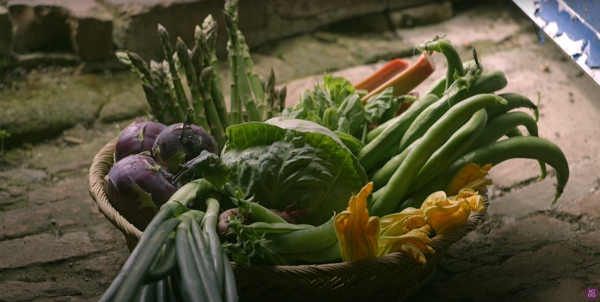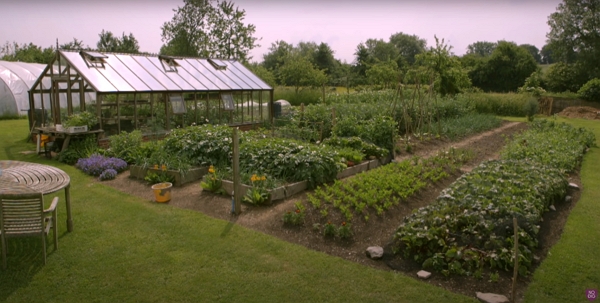Charles is showing us how his Homeacres is doing in early summer 2018.
Thanks to Charles Dowding for sharing his wisdom and knowledge! I wrote the following notes watching the video published on Charles Dowding’s channel. You can watch it using this YouTube link.
In early summer, everything is growing fast. So you need to be present and be on the lookout.
Weeding
Even if the No Dig method with cardboard works efficiently, the weeds don’t die out right away.
You need to watch for them to come out here and there for a few months or even a couple of years after applying the cardboard and compost layer.
The sure thing is that you won’t get as much, so it’s reducing the work performed.
Tidying up the garden
Interestingly, Charles tells us that the slugs like the old leaves of vegetables the most, kind of like they tidy up the place by eating what we won’t.
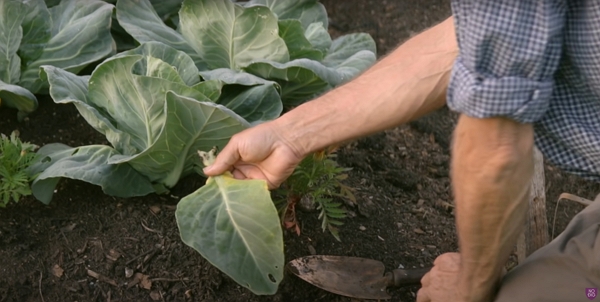
They have a role, they aren’t just there to annoy the gardener.
So here, we learn that to keep the slug away, clean the vegetables from old leaves. I’m interested to see how I can put this into action next spring.
Succession cropping
In early summer, some vegetables near readiness for harvest, you will be able to replace the old crops with new ones.
Sowing in module trays the next crops in advance is key to maximize the growing seasons.
For example, you can sow beetroots in modules, 4 weeks before you harvest cabbages, so that they’re ready to plant right after the cabbage harvest.
Another example is replacing broad beans with cabbage in the beginning of summer.
What can you sow in the beginning of June in the UK
Boltardy beetroot
It’s a fast-growing variety and it can be used for early sowing.
Beetroots are sown in pockets of about 4 seeds, remembering that some seeds won’t germinate.
Charles thins the seedlings down to 4 beetroots per module.
Spring onions
They’re sown in pockets of about 8–10 seeds per module.
Spring onions are very versatile because you can eat them when they’re small, or let them grow into bulbs.
Gowrie swede
They’re sown in pockets of about 2–3 seeds per module.
Then, you will need to thin to one root.
What else? In mid to late spring, Charles sowed the following, which are ready to be planted in the beginning of June:
- Red cabbage
- Kale
- Leak
- Brussels sprouts
- Runner beans
- Cucumber
Growing seedlings
They will need warmth.
In early summer, it’s easy to have warmth, but for Charles in the UK, he puts his seedling in the greenhouse, watering them every day.
More about spring onions that grew during the winter
Charles planted the spring onions below last August.
If you want to eat them, you need to watch out the seed head, unless you want to harvest seeds.
A spring onion will turn a bit woody if left too long in the ground with the seed head growing.
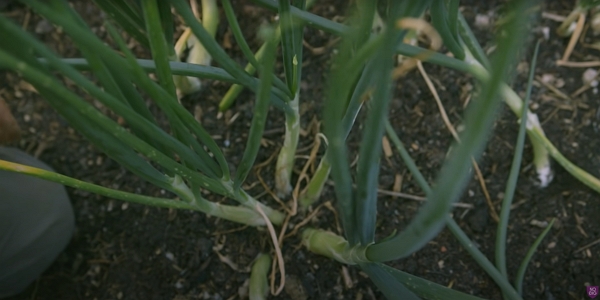
Planting leaks while clearing space
Charles clears out some kohlrabi sown in February, planted early April with a net on to prevent cabbage root flies to attack them.
About cabbage root flies
Charles doesn’t have a solution against the cabbage root flies except for the net over it.
He talked about another technique, but people have reported it doesn’t work.
Then, you will need to remove any weed.
You can also walk on the bed, especially after harvesting kohlrabi or anything with big roots to firm the compost again.
Remember
Walking on your bed covered with compost, you can’t compact it. You’ll firm it.
In summer, you will need to water the compost if dry.
Why not make your bed too mounded
When you pour water on it, even with a soil covered with compost, the water will run off to the sides.
So you want the bed to be leveled. It’s easier to water and keep the moisture on the bed.
After you watered maybe a second time, you’re ready to plan the leaks.
If you want a longer white stem, you need to plan them deep.
Intersow a new crop with another growing
Why would you do that?
Often, you will run out of space to sow the next crop.
But it’s possible if you intersow.
For example, Charles is sowing carrots between lettuce.
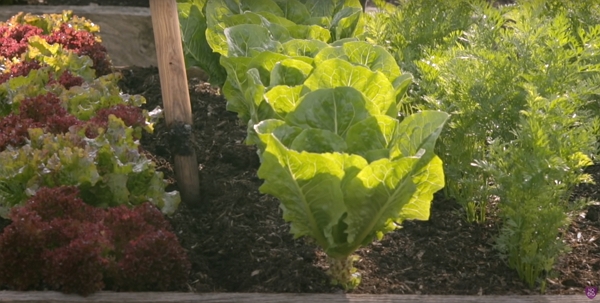
You will need to water well on the inside of the trench only so it’s efficient in water usage.
Tip
Wait a little bit before sowing the seeds, just like for the leeks earlier.
Sowing carrots requires precision. You don’t want too many sown in the same space. It’s always possible to thin them. But you could also save seeds by sowing just what you need.
Charles advices to sow one or two seeds every centimeter.
Finally, after putting back the compost over the seeds, walk on the compost to firm it up.
You don’t need to water more if you followed the watering of the trench at the beginning.
Timing of planting
You can easily plant too early. So learn about your climate and when it’s best to plant.
Curry squash and climbing bean need warmth so planting in late may to early June for zone 8 in the UK
In contrast, broad beans (fève in French) are planted in November to December.
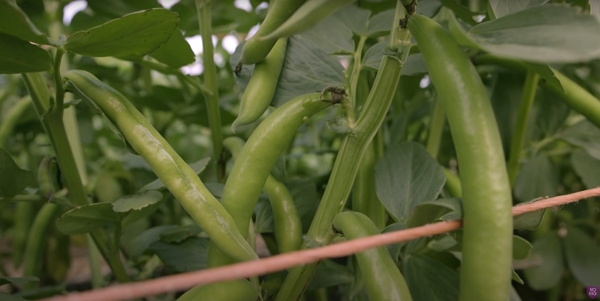
The same goes for celery, an early winter crop, that needs warmth.

Next, Swiss chard also like the warm sun. Charles sows them in mid-April for a planting 2 to 3 weeks later.

Growing climbing beans with a tippee structure
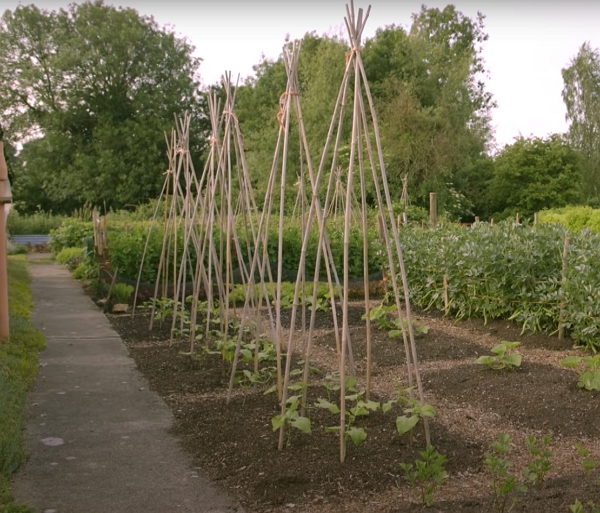
You have probably seen the structure of growing beans on a wall-like structure.
It tends to weaken against the wind, while tippees show more sturdiness, as they diffuse the wind coming onto them.
About watering
Watering well when planting is key. Use a good amount to make the soil really moist.
Then, don’t water them for a while, the plants will then need to make their roots down, looking for water.
But it isn’t the case for lettuce. The vegetables you harvest regularly need watering the most.
Coriander, spinach, peas fall in that category as well. Always depending on your weather, watering once every 2–3 days is enough.
With compost, it slowly releases the water to the plants, as it acts as a sponge
Personal note
Where I live in Ardèche, I do also water every other day.
The most difficult time is when the sun literally burns everything like this past summer.
So think about shading. It doesn’t have to block all the sun, but it will help tremendously to keep your crops alive.
Reminders about compost
You need to give air to the compost, using a compost mixer tool, like this one that I use for two years now.
I sue the technique of filling out my heaps in layers with green and brown. The green comes from the kitchen waste I throw away (5 liters per day) and the brown comes from dead leaves.
You can put weeds in the compost, but you will need heat. A big heap allows you to build up sufficient heat.
Keep your compost covered, the worms will thank you for that as they like dark and moist.
